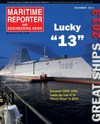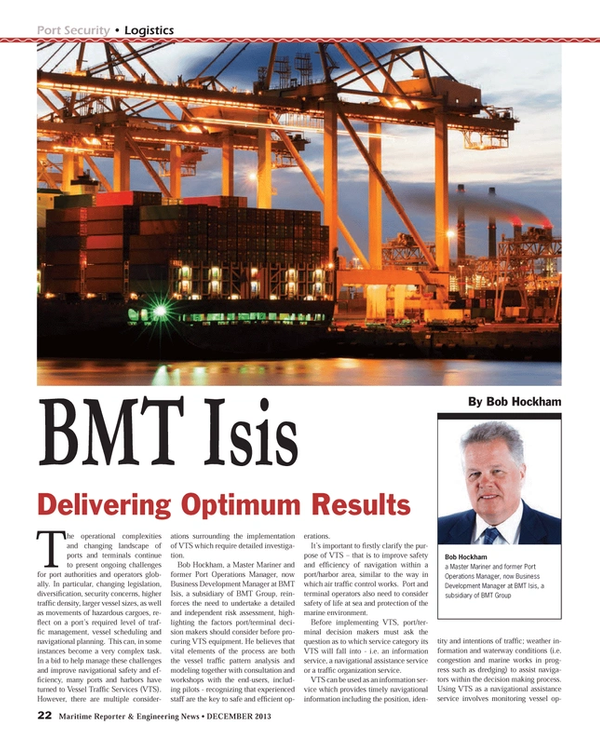
Global Port Security and BMT Isis
Delivering Optimum Results
The operational complexities and changing landscape of ports and terminals continue to present ongoing challenges for port authorities and operators globally. In particular, changing legislation, diversification, security concerns, higher traffic density, larger vessel sizes, as well as movements of hazardous cargoes, reflect on a port’s required level of traffic management, vessel scheduling and navigational planning. This can, in some instances become a very complex task. In a bid to help manage these challenges and improve navigational safety and efficiency, many ports and harbors have turned to Vessel Traffic Services (VTS). However, there are multiple considerations surrounding the implementation of VTS which require detailed investigation.
Bob Hockham, a Master Mariner and former Port Operations Manager, now Business Development Manager at BMT Isis, a subsidiary of BMT Group, reinforces the need to undertake a detailed and independent risk assessment, highlighting the factors port/terminal decision makers should consider before procuring VTS equipment. He believes that vital elements of the process are both the vessel traffic pattern analysis and modeling together with consultation and workshops with the end-users, including pilots - recognizing that experienced staff are the key to safe and efficient operations.
It’s important to firstly clarify the purpose of VTS – that is to improve safety and efficiency of navigation within a port/harbor area, similar to the way in which air traffic control works. Port and terminal operators also need to consider safety of life at sea and protection of the marine environment.
Before implementing VTS, port/terminal decision makers must ask thequestion as to which service category its VTS will fall into - i.e. an information service, a navigational assistance service or a traffic organization service.
VTS can be used as an information service which provides timely navigational information including the position, identity and intentions of traffic; weather information and waterway conditions (i.e. congestion and marine works in progress such as dredging) to assist navigators within the decision making process. Using VTS as a navigational assistance service involves monitoring vessel operator navigational decision making and the resulting effects on the navigational situation. This can be provided as either a contributory or a participatory service. Delivering a traffic organization service, VTS is implemented to prevent dangerous maritime traffic situations from occurring within the VTS monitored area. This provision is likely to be much more comprehensive and will require a larger investment in equipment, manning and support. Each of these services has their own benefits and risks which must be individually assessed.
When deciding on the level of VTS you require and in turn, the investment needed to deliver that particular service, there is a need to consider proportionality as a particular large scale investment may not be desirable or effective for the smaller inland river ports.
In order to better inform decision makers, a detailed, independent risk assessment should be carried out as this will provide the necessary information which is influential in determining the level of VTS investment required, including traffic types and patterns, the proximity of worksites, offshore installations and environmentally sensitive areas. To ascertain the level of VTS required, port and terminal operators should consider the requirement for areas such as forward planning of vessel movements, anticipated congestion and likelihood of dangerous incidents, as well as the likely movement of vessels restricted in their ability to maneuver, such as heavy transport vessels. Furthermore, traffic monitoring services will require specialized radar and other monitoring equipment, to minimize interference and blind sectors due to close proximity of buildings, structures and other vessels.
Other factors that must be considered before selecting VTS equipment include:
• The VTS equipment will need to be technically capable of monitoring navigation and providing responsible authorities with adequate operational information, within the designated port authority area.
• There should be a degree of upgradeability planned into the implementation of the VTS equipment and service to future proof against changes in legislation and port operational trends such as, changing trading patterns and vessel types, future renewables deployments near to and within the VTS managed sailing area and LNG bunkering.
• The supplier of the VTS equipment and peripherals such as radars and communications equipment should be able to confirm long term availability of spare parts and service support. The port authority may need to consider implementing an in-house maintenance team.
• Redundancy should be built into the VTS system in terms of both equipment and personnel backup, to reduce the possibility of down time (such as backup power systems, emergency VTS control stations, backup radar/AIS receivers, VTS qualified pilots and harbour officials to cover absence due to sickness etc.).
• The operating authority should consider availability of training and validation services for VTS operators, as well as travel constraints such as the remote location of VTS stations which may require forward planning.
• The operating authority will need to have a clear understanding of the distinction between different categories of VTS so that the most appropriate level of VTS for local operations is selected. This is by reference to definitions provided by the International Association of Marine Aids to Navigation and Lighthouse Authorities (IALA), the International Maritime Organization (IMO) and in the UK MGN 238 (M+F).
Given the often complex nature of VTS systems, operator training is key. Operating authorities must incorporate ‘on the job training’ under supervision of experienced operators. The production of a VTS trainee workbook which clearly identifies tasks, deadlines and officers who will be responsible for signing off on completed tasks is also vital. Operator workload will be influenced by the density of navigation being monitored and will, in turn, reflect on the VTS operator work schedule (shift and rest periods and watch rotas) to be implemented. Therefore, reference will need to be made to the Working Time Directive to ensure operators receive the appropriate rest periods and annual leave. Communication channels and the implementation of discrete VHF/DVHF radio channels for VTS/vessel communications, as well as legislative requirements such as the Pilotage Act 1987, local byelaws and sailing direction must also be addressed within the decision making process.
Given the vast number of variables involved in vessel traffic management, ports and harbors certainly qualify as ‘complex systems’ and operators are becoming more aware of the possibilities of failures and accidents. With this in mind there is a growing need for more effective communication between VTS operating authorities to encourage the sharing of expertise and experience. Regardless of the level of VTS investment, ports and terminals must recognise that well trained and experienced operators are the backbone to delivering safe and efficient operations. Only then will they feel confident that they have the most economical and suitable system which provides maximum safety.
Top 10 Tips
1. Invest in predeployment traffic and risk management studies to clearly understand the needs of the sailing areas to be monitored, risks and required mitigations
2. Prioritize system requirements.
3. Carry out regular reviews of the VTS operation to be aware of constraints and future investment requirements in order to maximize cost effectiveness and efficiencies.
4. Consider the VTS operator work arrangements in terms of shift patterns, rest periods and absence back-up for VTS operators.
5. Consider ongoing VTS operator training and V103 certification requirements.
6. Provide VTS operator training and career development plans to maximize morale and encourage staff retention - experienced staff are key to safe and efficient VTS operations.
7. Invest in visiting and maintaining dialogue with working VTS operating ports to share experiences.
8. Consult with pilots and encourage their input into effective VTS operations.
9. Consider various ways of working with VTS suppliers regarding different methods of procuring equipment such as leasing or outright purchase.
10. Consider on-going system maintenance requirements and the need for dedicated in-house support.
(As published in the December 2013 edition of Maritime Reporter & Engineering News - www.marinelink.com)
Read Global Port Security and BMT Isis in Pdf, Flash or Html5 edition of December 2013 Maritime Reporter
Other stories from December 2013 issue
Content
- Coming your way, a 3% rise in Operating Costs page: 10
- Five Minutes With: Tore Morten Olsen, Astrium Services page: 12
- Marine Cybersecurity: Is Your Ship Safe? Are You Sure? page: 16
- U.S. Export Reform: New Year, New Rules page: 18
- U.S. Port Security and the Impact of Sequester & Budget Woes page: 20
- Global Port Security and BMT Isis page: 22
- LED Lighting: Reduced Costs, Enhanced Safety page: 24
- India's Maritime Growth Fueled by Foreign Companies page: 26
- New Crane from Liebherr for Harbors, Offshore page: 28
- Ship Power: Out of the Past Comes Wärtsilä's Engine of the Future page: 30
- The Navy’s Battlewagon of the 21st Century page: 34
- Maersk’s Mammoth Containerships Making History page: 40
- New Bulk Carrier from Imabari Offers Unique Advantages page: 42
- Damen PSV 3300: A Diamond in the Rough page: 43
- Bourbon and CGG Partner for Seismic Survey Success page: 44
- Great Ships of 2013: Shuttle Tanker RIO 2016 for TEN page: 45
- Great Ships of 2013: Bow Pioneer page: 46
- Great Ships of 2013: Hornbeck’s HOSMAX 300 Series page: 47
- Great Ships of 2013: Oceanex Connaigra page: 48
- Great Ships of 2013: Hydra Voyager page: 48
- Great Ships of 2013: Damen Modular Barge page: 49
- What’s New with Floating Production? page: 50
- New Monitoring System from Rexroth page: 56
- Regal Motors Win Russian OK page: 56
- Jotun Debuts New Eco Antifouling page: 56
- New “Energy Demand Forecast System for Ships” page: 56
- Ultra Steam Turbine Plants page: 56
- Delta Plasma Rotator Launched page: 56
- LaBorde Launches New Compact Power Unit page: 56
- MTU Gensets for British Combat Ship page: 57
- Product Spotlight: Viking LifeCraft Evacuation System page: 57
- Sherwin-Williams Launch Marine Coatings App page: 57
- SMT Develops Robotic Tube Cutter page: 57
- Optimarin Inks Ballast Water Treatment Deal with V.Ships page: 57
- SturdiLED LED Floodlight Released page: 57
- IHC Debuts “Zero-Pollution” Seal page: 57


